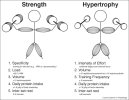Load is subjective, as ive clearly outlined in the sources ive cited, hypertrophic response is similar across rep ranges (within reason, under 30, probably due to cardiovascular limitations rather than musclular) so long as the last 5 reps were sufficiently close to failure. We can derive from this information that any set between 5-30 reps when taken to failure will be similarly hypertrophic.
and this is supported almost universally in the literature.
Background: Effective hypertrophy-oriented resistance training (RT) should comprise a combination of mechanical tension and metabolic stress. Regarding training variables, the most effective values are widely described in the literature. However, ...

www.ncbi.nlm.nih.gov
the benefic of higher reps with more manageable loads is that it may be easier to achieve failure, or a greater percentage to failure.
for example:
if you ware performing a movement with a weight that you would fail at 6 reps with but stop at 5 when it becomes extremely difficult, you stopped one rep shy of failure, however that 1 rep was 1/6 of your total work.
now if we select a load that we will fail at 15, and stop 2 reps shy of failure, we missed out on 1/7.5 of our total potential work. Thus getting the trainee closer to failure than in the lower rep example.
meaning missing that one rep with a higher weight lower rep set had a fairly large margin to be lost by not going to actual failure. While missing two reps at a higher rep range had a lower proportionate loss of work
This does not mean that higher rep ranges are more hypertrophic than lower rep ranges (at least greater than 5 reps), it simply means that an individuals capacity for reaching failure or at least getting closer to failure is much higher in the upper rep ranges.
It is for this exact reason that the majority of my own training is in the 8-15 rep range. Its not because there is some magic that happens in any particular rep range between 5-30 reps, it simply means that your margins for reaching failure are much larger and missing a single rep isnt nearly as impactful as in the lower rep ranges.



